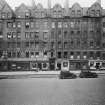Edinburgh, 322, 324, 326 And 328 Lawnmarket, Riddle's Close And Court
Tenement (18th Century)
Site Name Edinburgh, 322, 324, 326 And 328 Lawnmarket, Riddle's Close And Court
Classification Tenement (18th Century)
Alternative Name(s) Town And Gown Association
Canmore ID 52289
Site Number NT27SE 269
NGR NT 25552 73543
Datum OSGB36 - NGR
Permalink http://canmore.org.uk/site/52289
- Council Edinburgh, City Of
- Parish Edinburgh (Edinburgh, City Of)
- Former Region Lothian
- Former District City Of Edinburgh
- Former County Midlothian
NT27SE 269 2555 7354
Built by Captain George Riddell, wright, in 1726. Five-storey and attic; ground floor as shops. Stair tower at rear of 324 with date 1726 over doorway. Renovated S Henbest Capper 1893 and again in 1958-9 as flats, J Wilson Paterson.
RCAHMS 1951.
Riddle's Close was named for George Riddell, wright and burgess, who rebuilt the foreland in 1726. It was in a flat in theis Riddal's Land that the forty-year-old philosopher David Hume first set himself up as a householder. In 1730 the close was referred to as "Sir James Smith's Close, now Royston's Close"; the first referring to Sir James Smith of Groathill, Provost 1643-46, who lived in the cross house between the two courtyards; while the later name was for Sir James Mackenzie, who lived in the lower part of the MacMorran mansion and sat as Lord Royston in the Court of Session 1710-44. Yet another name for the close was Shaw's Close, evidently for Bernard Shawe, one of the resident owners in 1635. While the northern courtyard is modern, created by clearances in 1893, the buildings round the North, West and South sides of the south courtyard (Riddle's Court is a misnomer) were built about 1587 by John MacMorran, merchant burgess.
(from Stuart Harris, "Place Names in Edinburgh", 1996, pages 527-8).
Publication Account (1951)
18. 312-328 Lawnmarket.
[see also NT27SE 270]
The two neighbouring lands, each of five storeys and an attic, which stand on the S. side of the Lawnmarket in front of Riddle's Court are unusually good specimens of early Georgian housing of the better class, fashioned out of two earlier buildings. Each distinguished by three gablets with curvilinear pediments towards the street, they are more or less T-shaped on plan and generally similar, but the W. one, which was built by Captain George Riddell, wright, in 1726,* has a rubble front relieved by a single string-course and back-set dressings of freestone, while the front of its neighbour, rebuilt in 1752 by Thomas Fisher, merchant, is of ashlar without string-courses. The ground floor in both cases has been remodelled as shops, but it still includes two original passages leading S., one admitting to Fisher's Close and the other to Riddle's Court. The newel stairs that give access to the flats in the upper storeys project into the Close and the Court respectively. Both the stair-entrances have moulded doorways, the W. one bearing the date 1726. The fronts have eight large windows on each of the principal floors, but each storey of the W. building has, in addition, a small window lighting a closet within the W. gable. The attic floors are lit from a pair of windows in each of the gab lets, circular ventilators surmounting the W. lights. In both tenements there has been some internal rearrangement. In the W. tenement only a few of the rooms are panelled and retain the original marble mantelpieces, but every flat in the E. tenement shows traces of panelling while several of the original moulded stone fireplaces remain in use. This latter tenement generally has finishings of a rather earlier type than the other.
RCAHMS 1951
*Exercising its rights under an Act of 1663, which empowered burghs to seize, after due warning, houses fronting on their High Streets which had lain ruinous for three years, and to sell them at a price fixed by valuation the Town sold this property to Riddell for 10,000 perks in June 1726. In 1733 the place was described as 'Riddell's Land lately built by George Riddell, bound on the east by Fisher's Land and its close.












